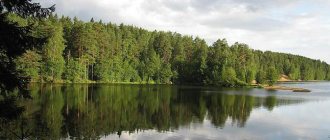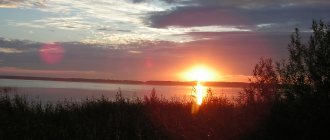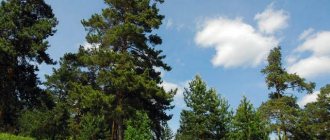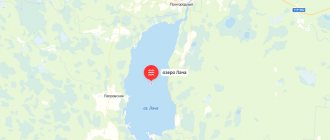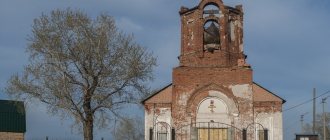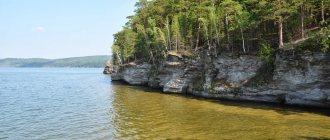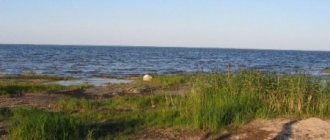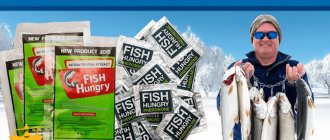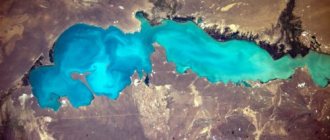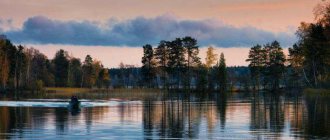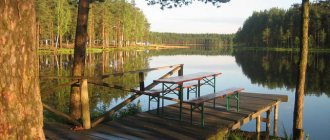Pyaozero is located in North Karelia, in the Louhi region, and is one of the favorite places for fishing among local residents and guests from neighboring regions. The lake appeared in 1966 as a result of the construction of the Kum reservoir, when a dam was erected.
The reservoir is large and very deep. The total area of the water surface is 658.7 km², the depth of the lake is on average about 15 meters, but in some places it reaches 49 meters. The lake got its name from the Finnish Pääjärvi, where “pya” is translated as head, and “järvi” means lake. Thus, the name means the main lake, into which all the main tributaries flow: Sofyanga, Mininka, Poncha, Pundoma, Karmanga, Taivoyokki. There are 66 islands on Pyaozero, the largest of which are visited for fishing, picking mushrooms and berries.
©
Fishing on Pyaozero
Most tourists go to the north of Karelia for surfing and fishing. Pyaozero, along with nearby Topozero, is one of the most attractive bodies of water in the region for fishing. And the point here is not only the large size of the lake. The Loukhi region is very sparsely populated. Several thousand people living in the region are scattered over a fairly large area. Thus, poaching, even if present, does not have too much of an impact on the stocking of fish in the lake.
In total, there are 16 species of fish in the reservoir: burbot, pike, ruffe, smelt, bleak, roach, perch, whitefish, trout, vendace, ide, perch, bream, sculpin, palia, grayling.
Brown trout
The most valuable commercial fish of Pyaozer is brown trout. It is this predator that fishing enthusiasts most often come to hunt for. This fish lives throughout the lake. But most of all it is in the central part of the reservoir. Since brown trout feed mainly on vendace and smelt, during the migration of these fish to spawn, brown trout live with them in shallow water. The trout themselves spawn in rivers; they mostly enter the river. Sofyanga, from where it goes to the river. Ponchu, b. Varbu, also goes to the rivers Kolo, Kitti, Cormanga, Tawang and Olanga.
Vuoshkalosari Island, ©
Palia
Palia is quite common in Pyaozero. In spring and early summer, it lives closer to the shores, feeding on smelt and vendace. When the water warms up in summer, the palia moves to those parts of the lake where the depth reaches 20–30 meters. When the water temperature drops again in the fall, the fish return to the shores and rise higher to the surface of the water. By the beginning of October, palia comes to spawn on the rocky shores of islands, located mainly closer to the middle of the lake, such as Maloshuari, Voccola, Tapparani, B. Perio, Paloshuari, Pirometchu, Kuzhshuari, Aringishuari.
vendace
This type of fish lives throughout the lake. The largest catches of vendace begin from mid-June to mid-July, in the fall during spawning in October. The most famous place for catching is Pyaiguba in the north of the reservoir. The coast along Sofianga, in the strait near the island, is also known for good catches. Talvishuari, in Umbikanda and Nikolskaya Bay.
©
Whitefish
There are up to 6 species of whitefish in Pyaozero. The largest catches begin in mid-June, when the fish approach the shallows to feed. By mid-summer, whitefish move to greater depths. This type of fish is hunted mainly off the western and northern shores of the island. Maloshuari, at Fr. Kurgonshuari, between the islands of Vartishuari and Lupchanga, in the river. Sofyanga and its tributaries.
What to fish with
In the summer, most fishermen fish with a rod, fly fishing, spinning and trolling. Brown trout are caught well with massive baits - “shakers” and diving wobblers. The pike goes on a spinning rod with a spinner and a jig. According to fishermen's reviews, grayling is also excellently caught on “shakers”. Most hunters prefer Mepps or Blue Fox number two or three with a white petal and a tan core.
Weather in Pyaozero for a week, 10, 14 days and a month - Gismeteo
Lip Olangalaksha, ©
Pyaozero
On Pyaozer I prefer to fish in the northern part. There are several places where you can launch a boat, you can find out about them from local residents. But in any case, you will have to get to the fishing spot and parking lot by boat. We walk about 15 km. We make our first trips of the season to this reservoir around mid-June. Weather conditions at this time vary greatly from year to year. The ice melts from mid-May to early June, and the activation of biting, especially non-salmon fish, depends on this event. In recent years, the average temperature has been slightly higher than usual, causing a lot of mosquitoes (in previous years there were none at all) and the water temperature has risen to 5-8°C (usually 2-4°C). This also affected the activity of the fish. Fishing on this reservoir is varied. The main fish species are brown trout, palia, grayling, whitefish, perch, pike and ide. The main objects of fishing are palya and brown trout. Both species live at fairly decent depths - sometimes they can be caught at 10 m, but usually bites occur at depths of 17-25 m. Naturally, you have to catch them by trolling.
Palia stays closer to the bottom than brown trout, so the use of deepening systems is simply necessary. There are much more bites with them. You can use a downrigger (but this requires a specially equipped boat) or individual deepeners for each rod. Usually the upper layers are fished first, and if fish are caught in sufficient quantities, they stop there, since brown trout often take from above, and they are much larger than palia. For brown trout, larger baits are used. I often catch it on narrow “shakers” or elongated wobblers with a small blade in order to reduce the already very strong drag of the deepener. The average weight of brown trout is 1-2 kg, but there are specimens up to 5-6 kg or even more. There are a lot of bites, and catching is not boring. Mostly fishing takes place along coastal dumps, since the depths come very close to the shore, but you can also catch good fish in open water. In 2009, in mid-June, palia and brown trout were caught in approximately the same proportions; in 2010, the situation changed - only one brown trout was caught, the rest were palia. This is usually what happens; brown trout begins to actively catch closer to autumn. Although palia is much smaller than brown trout and fishing for it is not very interesting, its gastronomic qualities are very high. You can fish around the clock, since the northern night in June is quite light. Or rather, there is no night at all, there is a slight twilight that never turns into darkness. By the way, it is during this twilight time that grayling and whitefish are best taken. They were very successfully caught in small channels between the islands, smoothly turning into small swamps. This is where the largest representatives of these species were caught. At this time, they were better caught with worms; only a few graylings were caught with a spinning rod. The largest specimens reached 1.5 kg - a very decent weight for these species. By mid-summer, the situation changes, and the same grayling begins to be caught wonderfully on small “spinners” and “shakers”. The best time for fishing is twilight, but the largest specimens were caught from 3 o’clock in the morning. In addition, from mid-summer, brown trout begin to dominate the catches, which are subsequently caught well until late autumn. We should also talk about pike. People rarely come here specifically for it, so in some places there is a lot of it. In some years, the pike is not very active, and only a few tails become prey, and in some years, it is possible to catch a great deal. Since this is a reservoir, there are places with half-submerged trees, both fallen and standing, and it is near them that the pike concentrates. We started catching here with ultralight grayling, which in the evenings approaches the snags in decent numbers, but after a few bites of spinners we realized that the main fish here were different, and switched to coarser gear. We caught mainly with subsurface wobblers and poppers, as well as jerkbaits and swimbaits, so the fishing turned out to be very spectacular; the attack of pike in clear water can be seen from afar. The largest specimens reached 7 kg, but much larger pikes have been spotted in the water. The weather changed several times, but this did not affect the bite very much. When fishing for pike by trolling, there are a lot of hooks, mostly on snags, some of which we even managed to lift from the bottom. In September, fishing is still varied; you can catch a lot of brown trout by trolling, and pike in smaller areas. Grayling is caught very well on ultralight, and sometimes whitefish are caught. In general, there are a lot of fish in the reservoir, but you need to find where it is and pick up the gear, then you can get complete satisfaction from fishing. Fishing and traveling are absolutely compatible things. When going on a bus tour around Russia, I usually don’t forget to take fishing gear with me. After all, most often bus tours from St. Petersburg can be very exciting, but one of my favorites is undoubtedly a bus tour to Seliger. I am sure all readers understood why it was her. After all, this is a comfortable bus, an interesting story from the guide during the trip, visits to wonderful places and the highlight of the program is Seliger itself, where you can do excellent fishing.
Islands
There are 66 islands on Pyaozero, the total area of which is more than 100 km². The most significant islands are Lupchanga, Mayashuari, Talvishuari, Laidoshuari, Vochkala and Maloshuari. Vuoshkalosari, like other large islands, has long been chosen by fishermen for their fishing. Most of them are equipped with good-quality huts and houses for those who want to stop for fishing in these places. Berries and mushrooms are also picked here during the season.
All islands are marked on the map, so you can get to the desired island yourself by boat. However, when traveling between the islands, you need to be careful: during the construction of the reservoir, part of the surrounding areas was flooded, so in some places there may be standing underwater forest and snags. It is best to use a depth map, which indicates the bottom topography and the approximate depth in a specific place in Pyaozer.
Map of the depths and islands of Pyaozer with names
Google maps panorama: view of Pyaozero from Mount Kivakka
Houses and bases on Pyaozero
Houses located on the islands can be rented for recreation and fishing. There are quite a few companies providing this service. Most of the houses are wooden huts, the capacity of which ranges from 2 to 10 people.
Most often, the internal contents of such a house are not rich and are designed for fishermen who come here during the season. Thus, the huts have beds and a stove, a dining table with benches, dishes for cooking, mattresses, blankets, and pillows. Near the houses there are fire pits; there are almost always barbecues, smokehouses and the necessary supply of firewood. Some houses are equipped with baths. For example, the number of rooms at the recreation center “Houses on Lake Pyaozero” has 18 equipped huts in different parts of the lake. Delivery to the islands is also carried out by companies that rent out houses. In addition, if necessary, you can rent boats and motors.
Sunset on Pyaozero, ©
Coastal zone
The banks of the reservoir have hills composed of sandstones. The northern part is mostly covered with pine forest. The coastal part is characterized by frequent windbreaks (especially on very protruding capes). In these places you can collect bark beetle for those who like to fish with a float, since it is impossible to dig up a worm here.
The southern coast is characterized by low, marshy areas of the coast. People often go to large islands like Vuoshkaloshuari to fish for berries. The rivers flowing into Lake Pyaozero (fishing is also possible here) originate from various lakes and swamps. The main river is Sofyanga. It flows out of Topozer. Another river, Olanga, flows into the northwestern part of Pyaozero. The following tributaries are of greatest importance: r. Tawanga (West Bank), Kormanga, Kela, Kitti, Tsipringa (North Bank) and the river. Pundoma (south bank). The northern section of the lake gives rise to the river. Kume. Through it, the waters of Pyaozero enter the lake system of Kundozero, Sokolozero, etc., entering Kovdozero. After spending your holiday on Lake Pyaozero, you will remember the local beauty for a long time.
Rest
The majority of vacationers here are fishermen, but there are also lovers of water trips. In the intervals between conquering the lake, they collect gifts from the forest, of which there are quite a lot in this part of Karelia. To collect berries, it is better to stock up on a hand harvester.
Holidays in North Karelia will appeal to lovers of untouched nature, because most of the areas here are deserted and uninhabited. However, there is infrastructure for those who are accustomed to civilization. Some recreation centers offer their guests not only fishing equipment, but also rental of ATVs, snowmobiles, airships, bicycles, sleds and skis in the winter season. The hotels themselves are equipped with baths, saunas, billiard tables and board games. In the hotel cafe you can order dishes of European and national cuisine. Tourists leave good reviews about the Niska recreation center, located in the village of Zasheyek.
Tourists note a large number of insects along the shores of the lake. Therefore, when going on vacation to Pyaozero, you need to take care of protective equipment. There are a little less midges near the islands in the middle of the lake, but they are there too.
Vuoshkalosari Island, ©
How to get to Pyaozer?
Getting to Pyaozero is not very difficult. Any train going to Murmansk is suitable for this. You can come to the Louhi railway station, and if you travel by car, then you should take the M-18 highway and turn left when you reach Louhi. This road leads to the village of Pyaozersky. There are great places here. It's not quite north, but it's not exactly south either. On the eastern shore there is one parking lot that makes it possible to drive up to Lake Pyaozero - Umbikanda Bay (access to the water). This is approximately 10 km before reaching Zasheyek. You need to go to Loukha, then to Kestenga and to Zasheyek for about 60-70 kilometers. Time – about three hours. For low-slung cars, there are some places where crossing is problematic. But you can drive... It is advisable to have a navigator with you. On the shore on the western side is the Paanajärvi National Park. The police and fisheries inspection are often here. There are parking spaces here. In general, there are few places for convenient parking. But there are a lot of rocky slopes. There are popular places, well equipped, where fishermen usually come for a long time.
